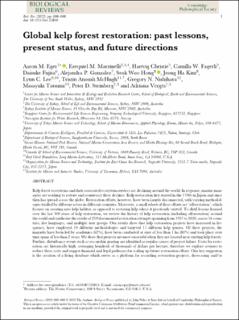| dc.description.abstract | Kelp forest ecosystems and their associated ecosystem services are declining around the world. In response, marine managers are working to restore and counteract these declines. Kelp restoration first started in the 1700s in Japan and since then has spread across the globe. Restoration efforts, however, have been largely disconnected, with varying methodologies trialled by different actors in different countries. Moreover, a small subset of these efforts are ‘afforestation’, which focuses on creating new kelp habitat, as opposed to restoring kelp where it previously existed. To distil lessons learned over the last 300 years of kelp restoration, we review the history of kelp restoration (including afforestation) around the world and synthesise the results of 259 documented restoration attempts spanning from 1957 to 2020, across 16 countries, five languages, and multiple user groups. Our results show that kelp restoration projects have increased in frequency, have employed 10 different methodologies and targeted 17 different kelp genera. Of these projects, the majority have been led by academics (62%), have been conducted at sizes of less than 1 ha (80%) and took place over time spans of less than 2 years. We show that projects are most successful when they are located near existing kelp forests. Further, disturbance events such as sea-urchin grazing are identified as regular causes of project failure. Costs for restoration are historically high, averaging hundreds of thousands of dollars per hectare, therefore we explore avenues to reduce these costs and suggest financial and legal pathways for scaling up future restoration efforts. One key suggestion is the creation of a living database which serves as a platform for recording restoration projects, showcasing and/or re-analysing existing data, and providing updated information. Our work establishes the groundwork to provide adaptive and relevant recommendations on best practices for kelp restoration projects today and into the future. | en_US |

